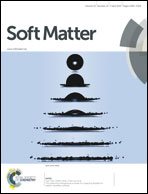Time resolved SAXS to study the complexation of siRNA with cationic micelles of divalent surfactants
Abstract
The complexation of siRNA (small interfering RNA) with cationic micelles was studied using time dependent synchrotron SAXS. Micelles were formed by two types of divalent cationic surfactants, i.e. Gemini bis(quaternary ammonium) bromide with variable spacer length (12-3-12, 12-6-12, 12-12-12) and a weak electrolyte surfactant (SH14) with triazine head. Immediately after mixing (t < 50 ms), new large aggregates appeared in solution and the scattering intensity at low q increased. Concomitantly, the presence of a quasi-Bragg peak at q ∼ 1.5 nm−1 indicated core structuring within the complexes. We hypothesize that siRNA and micelles are alternately arranged into “sandwiches”, forming domains with internal structural coherence. The process of complex reorganization followed a first-order kinetics and was completed in less than about 5 minutes, after which a steady state was reached. Aggregates containing Geminis were compact globular structures whose gyration radii Rg depended on the spacer length and were in the order of 7–27 nm. Complexes containing SH14 (Rg = 14–16 nm) were less ordered and possessed a looser internal arrangement. The obtained data, joint with previous structural investigation using Dynamic Light Scattering, Zeta Potential and Small Angle Neutron Scattering, are encouraging evidence for using these systems in biological trials. In fact we showed that transfection agents can be obtained by simply mixing a micelle solution of the cationic surfactant and a siRNA solution, both of which are easily prepared and stable.


 Please wait while we load your content...
Please wait while we load your content...